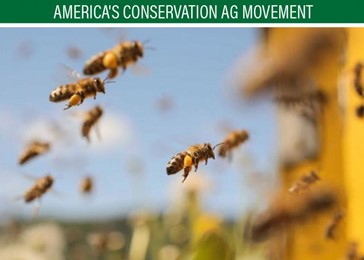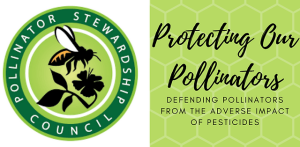Pollinator Habitat Fits Farmer’s Sandy Soils
This article was written by Brian Scott, an Indiana farmer, blogger https://thefarmerslife.com/ and a Conservation Steward for the America’s Conservation Ag Movement.
Farming sand doesn’t usually produce the most fruitful harvest come fall. Add in a woodland along one border, and the yields on the edges drop even more. A field we once rented but now own is going to have nine of its 23 acres put into a pollinator habitat cover with help from the USDA’s Natural Resources Conservation Service (NRCS), the Farm Service Agency (FSA), and the Conservation Reserve Program (CRP).
Flat, with decent soil on the south side, but with a steep rise to a sand hill on the north side, this field is only partially productive. Since we purchased the farm in 2017, we have yet to plant a crop on the hill. In the rental years we put dollars into seed, fertilizer and weed control. But unless it rained a lot, we wouldn’t see much grain in the combine at harvest due to the sand. Couple that with a meandering, yield-robbing tree line while starting the year planting 60’ wide along the curves on a small, 9-acre patch, and there’s just not a return on investment.
We already participate in CRP. Having enrolled grass buffer strips along most of the drainage ditches running beside our fields, we decided to see what the program offered for our little sand hill. As it turned out, a pollinator habitat practice fit the bill nicely. Two years in the making to get all the stars (and funding) to align, it looks like spring 2021 will see the sand hill seeded to a prescribed pollinator mix. Between the cost share payment for about half the seed which costs quite a few dollars, and the annual CRP payments going forward, we figure our costs will be recouped in year two. By the third year we’ll be making a little money. Certainly, because we are reducing our fertilizer, energy and pesticide costs, more than continued futile attempts to grow corn and soybeans on the beach make little sense.
Pollinator populations have been declining rapidly in recent years. Most of us are familiar with the colony collapse disorder (CCD) that hit honey bee colonies around 2006. The CCD and other factors, such as poor nutrition from loss of foraging habitat and pathogens (particularly varroa mites), have been associated with hive mortality that has averaged around 30% each winter. Less visible but just as important is the sharp decline in native pollinators. Adopting practices that provide nutrition for pollinators addresses one of the factors associated with these declines.
Because pollinators require a food source throughout their foraging season, the CRP pollinator habitat practice requires a seed mix that includes seeds for multiple plants that bloom across the growing season. The minimum seed mix requires seed from three plants that bloom in each of the early, mid- and late-flowering seasons. We choose a more diverse seed mix. It only weighs 25 pounds but includes seed for 24 different flowering plants (see seed list below). This seed mix will also provide habitat for bobwhite quail, pheasant and songbirds.
For our farm, the pollinator habitat practice will work by reducing costs, establishing a year-round cover that protects the soil from erosion, protecting water quality, as well as providing wildlife habitat.
Seed Mix Used:
Graminoid
Little Bluestem
Prairie Dropseed
Sand Lovegrass
Prairie Junegrass
Sideoats Grama
Forbs and Legumes
Frost Aster
Hairy Beardtongue
Spotted Bergamot
Black-Eyed Susan
Tall Blazing Star
Common Evening Primrose
Compass Plant
Gray-Headed Coneflower
White Prairie Clover
Purple Coneflower
Lanceleaf Coreopasis
Field Goldenrod
Stiff Goldenrod
Lead Plant
Wild Lupine
Butterfly Milkweed
Slender Mountain Mint
New Jersey Tea
Purple Prairie Clover
Rasinweed
Round-Headed Bush Clover
Common Spiderwort
Hoary Vervain
Note: We will be following along with Brian’s pollinator habitat as he goes through his first year of implementation. If you are interested in learning more about how NRCS can help you incorporate conservation practices on your land, contact Ethan White, Manager of Farmer Outreach and Engagement at Trust In Food™, a Farm Journal initiative, and he will direct you to the right resource in your state. If you would like to know more about the work Brian is doing with America’s Conservation Ag Movement, go to www.trustinfood.com/americas-conservation-ag-movement/; or, email us at conservationag@farmjournal.com.









